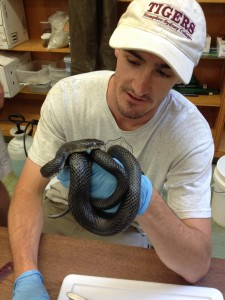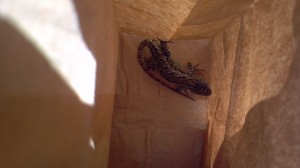The purpose of my research project is to sample the local population of squamates for ranavirus. The virus has caused die offs in amphibians as well as squamates. At the beginning of my research, I was specifically focused on snakes because of the lack of research that has been done on snakes and ranavirus. But, since I was seeing so many other reptiles, Professor Goodman decided it would be alright for me to collect lizards and turtles as well.
Every morning and evening rain or shine, I go out to one of the sites found around campus and check all the covers at that site. We use covers because they have been shown to be more successful in catching snakes than other techniques. There are 4 sites each with 54 covers made of either tin or plywood. I record everything I find underneath the covers, and I capture any reptiles I find underneath. Around 10 a.m. each day, I go to the lab to process the specimens that were caught the day before or earlier that morning.
Processing the animals involves collecting samples from each specimen. For turtles, Professor Goodman and I normally swab them and take a tissue sample from the tail by snipping a little bit off. For lizards and snakes we take tail tissue samples. We have a unique method for marking each squamate. We carve notches in the turtle shells, clip the lizard’s toes and we use a cauterizing tool to mark the snake’s scales on their underside. Since some of the reptiles might be infected with ranavirus, we are really careful during processing to keep everything disinfected.
Once the specimen has been processed, we return it to the area in which it was found. The majority of my work has been done in the field, and it has been a lot of fun. So far, I have caught 32 fence lizards, 9 five lined skins, 5 worm snakes, 20 Eastern Box Turtles, 1 ringneck snake and 1 rat snake. The time I spend out in the woods is very peaceful, and I have seen a lot of things that I will not soon forget.


